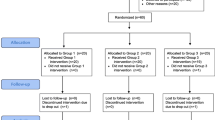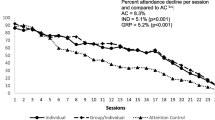Abstract
Incentive programs directed at both providers and patients have become increasingly widespread. Pay-for-performance (P4P) where providers receive financial incentives to carry out specific care or improve clinical outcomes has been widely implemented. The existing literature indicates they probably spur initial gains which then level off or partially revert if incentives are withdrawn. The literature also indicates that process measures are easier to influence through P4P programs but that intermediate outcomes such as glucose, blood pressure, and cholesterol control are harder to influence, and the long-term impact of P4P programs on health is largely unknown. Programs directed at patients show greater promise as a means to influence patient behavior and intermediate outcomes such as weight loss; however, the evidence for long-term effects are lacking. In combination, both patient and provider incentives are potentially powerful tools but whether they are cost-effective has yet to be determined.
Similar content being viewed by others
References
Papers of particular interest, published recently, have been highlighted as • Of importance •• Of major importance
•• Loewenstein G, Brennan T, Volpp KG. Asymmetric paternalism to improve health behaviors. JAMA. 2007;298:2415–7. A good description of how behavioral economics can be used to help improve health behaviors.
Johnson EJ, Goldstein D. Do defaults save lives? Sci Justice. 2003;302:1338–9.
Thaler RH, Mullainathan S. Behavioral economics. The Concise Encyclopedia of Economics. 2008. Available at: http://www.econlib.org/library/Enc/BehavioralEconomics.html. Accessed October 10, 2012.
Bell CM, Levinson W. Pay for performance: learning about quality. CMAJ. 2007;176:1717–9.
Epstein AM. Paying for performance in the United States and abroad. N Engl J Med. 2006;355:406–8.
Longo DR, Schubert SL. Issues in pay for performance: the case of diabetes self-management. J Health Care Finance. 2006;33:17–23.
•• Scott A, Sivey P, Ait Ouakrim D, et al. The effect of financial incentives on the quality of health care provided by primary care physicians. Cochrane Database of Syst Rev. 2011;9:CD008451. This Cochrane Review evaluates the impact of different financial interventions on the quality of care delivered by primary care physicians (PCPs). A total of 7 rigorously-designed studies published between 2000–2009 were evaluated; all studies were randomized controlled trials (RCTs), controlled before and after studies (CBA), or interrupted time series analyses (ITS). Three of the studies included diabetes specific metrics.
•• Campbell S, Reeves D, Kontopantelis E, et al. Quality of primary care in England with the introduction of pay for performance. N Engl J Med. 2007;357:181–90. A comprehensive evalaution of England's program including diabetic specific outcomes.
NHS website. Available at: http://www.qof.ic.nhs.uk/. Accessed October 2, 2012.
Doran T, Fullwood C, Gravelle H, et al. Pay-for-performance programs in family practices in the United Kingdom. N Engl J Med. 2006;355:375–84.
Quality and outcomes framework for 2012/13. Available at: http://www.nhsemployers.org/Aboutus/Publications/Documents/QOF_2012-13.pdf. Accessed October 2, 2012.
Campbell SM, Roland MO, Middleton E, Reeves D. Improvements in quality of clinical care in english general practice 1998–2003: longitudinal observational study. BMJ. 2005;331:1121.
• Vaghela P, Ashwort M, Schofield P, Gulliford MC. Population intermediate outcomes of diabetes under pay-for-performance incentives in England from 2004 to 2008. Diabetes Care. 2009;32:427–9. An evaluation of diabetes-specific outcome metrics for 98 % of all English family practices. There was an improvement in all metrics after the initiation of QOF; however, data was only analyzed from 2004–2007, limiting the analysis.
Hippisley-Cox J, Vinogradova Y, Coupland C. Time series analysis for selected clinical indicators from the quality and outcomes framework 2001-2006’, final report for the information centre, version 1.1, R22 HSCIC (2007). Available at: http://www.qresearch.org/Public_Documents/Time%20Series%20Analysis%20for%20selected%20clinical.pdf. Accessed October 2, 2012.
Hamilton FL, Bottle A, Vamos EP, et al. Impact of a pay-for-performance incentive scheme on age, sex, and socioeconomic disparities in diabetes management in UK primary care. J Ambul Care Manag. 2010;33:336–49.
Crawley D, Ng A, Mainous AG, Majeed A, Millett C. Impact of pay for performance on quality of chronic disease management by social class group in England. JR Soc Med. 2009;102:103–7.
Millett C, Gray J, Saxena S, et al. Ethnic disparities in diabetes management and pay-for-performance in the UK: the Wandsworth prospective diabetes study. PLoS Med. 2007;4:e191.
Millett C, Bottle A, Ng A, et al. Pay for perfomance and the quality of diabetes management in individuals with and without co-morbid medical conditions. JR Soc Med. 2009;102:369–77.
Whyte S, Penny C, Phelan M, Hippisley-Cox J, Majeed A. Quality of diabetes care in patients with schizophrenia and bipolar disorder: Cross-sectional study. Diabet Med. 2007;24:1442–8.
Rosenthal MB, Landon BE, Normand SL, Frank RG, Epstein AM. Pay for performance in commercial HMOs. N Engl J Med. 2006;355:1895–902.
Terry K. Pay for performance. How fast is it spreading? Available at: http://medicaleconomics.modernmedicine.com/memag/content/printContentPopup.jsp?id=190108. Accessed October 2, 2012.
Levin-Scherz J, DeVita N, Timbie J. Impact of pay-for-performance contracts and network registry on diabetes and asthma hedis measures in an integrated delivery network. Med Care Res Rev. 2006;63(1 Suppl):14S–28.
Claffey TF, Agostini JV, Collet EN, Reisman L, Krakauer R. Payer-provider collaboration in accountable care reduced use and improved quality in Maine medicare advantage plan. Heal Aff. 2012;31:2074–83.
Rosenthal MB, Frank RG, Li Z, Epstein AM. Early experience with pay-for-performance: From concept to practice. JAMA. 2005;294:1788–93.
Chen JY, Tian H, Taira Juarez D, et al. The effect of a PPO pay-for-performance program on patients with diabetes. Am J Manag Care. 2010;16:e11–9.
Young G, Meterko M, Beckman H, et al. Effects of paying physicians based on their relative performance for quality. J Gen Intern Med. 2007;22:872–6.
Coleman K, Reiter KL, Fulwiler D. The impact of pay-for-performance on diabetes care in a large network of community health centers. J Health Care Poor Underserved. 2007;18:966–83.
CMS Fact Sheet. Available at: http://www.ntocc.org/Portals/0/PDF/Attachments/PublicPolicyUpdates/FSV-MPFS-2013-NPRM-20120706.pdf. Accessed October 2, 2012.
• Long JA, Jahnle EC, Richardson DM, Loewenstein G, Volpp KG. Peer mentoring and financial incentives to improve glucose control in African American veterans: A randomized trial. Ann Intern Med. 2012;156:416–24. Only published randomized control trial evaluating financial incentives to improve diabetic outcomes.
Austin S, Wolfe BL. The effect of patient reminders and gas station gift cards on patient adherence to testing guidelines for diabetes. WMJ. 2011;110:132–7.
Raiff BR, Dallery J. Internet-based contingency management to improve adherence with blood glucose testing recommendations for teens with type 1 diabetes. J Appl Behav Anal. 2010;43:487–91.
Cafazzo JA, Casselman M, Hamming N, Katzman DK, Palmert MR. Design of an mHealth app for the self-management of adolescent type 1 diabetes: a pilot study. J Med Internet Res. 2012;14:e70.
Schauer PR, Kashyap SR, Wolski K, et al. Bariatric surgery vs intensive medical therapy in obese patients with diabetes. New Engl J Med. 2012;366:1567–76.
Chen L, Magliano DJ, Zimmet PZ. The worldwide epidemiology of type 2 diabetes mellitus– present and future perspectives. Nat Rev Endocrinol. 2012;8:228–36.
Mingrone G, Panunzi S, De Gaetano A, Guidone C, Iaconelli A, Leccesi L, et al. Bariatric surgery vs conventional medical therapy for type 2 diabetes. New Engl J Med. 2012;366:1577–85.
•• Volpp KG, John L, Troxel AB, et al. Financial incentive-based approaches for weight loss: a randomized trial. JAMA. 2008;300:2631–7. A randomized control trial of 2 different incentive structures both of which led to greater weight loss than usual care.
Kullgren JT, Loewenstein G, Troxel AB, et al. A randomized controlled trial of financial incentives to promote weight loss among obese employees: Presented at the Society of General Internal Medicine 2012 National Meeting, Orlando, FL.
Jeffery RW, Drewnowski A, Epstein LH, et al. Long-term maintenance of weight loss: current status. Health Psychol. 2000;19(1 Suppl):5–16.
Elfhag K, Rössner S. Who succeeds in maintaining weight loss? A conceptual review of factors associated with weight loss maintenance and weight regain. Obes Rev. 2005;6:67–85.
Roland M. Linking physicians’ pay to the quality of care– a major experiment in the United Kindgrom. N Engl J Med. 2004;351:1448–54.
• Halpern SD, Madison KM, Volpp KG. Patients as mercenaries? The ethics of using financial incentives in the war on unhealthy behaviors. Circ Cardiovasc Qual Outcomes. 2009;2:514–6. A good discussion of the ethical concerns raised by fiancial incentives for patients.
Mitnick S, Snyder L, Hood VL. America College of Physicians Ethics, Professionalism and Human Rights Committee 2010 Position Paper. Ethical considerations for the use of patient incentives to promote personal responsibility for health: West Virginia medicaid and beyond. Available at: http://www.acponline.org/running_practice/ethics/issues/policy/personal_incentives.pdf. Accessed October 2nd, 2012.
Lester H, Schmittdiel J, Selby J, et al. The impact of removing financial incentives from clinical quality indicators: longitudinal analysis of 4 Kaiser Permanente indicators. BMJ. 2010;340:c1898.
Bishop G, Brodkey AC. Personal responsibility and physician responsibility–West Virginia's medicaid plan. N Engl J Med. 2006;355:756–8.
Shaw J. Is it acceptable for people to be paid to adhere to medication? No. BMJ. 2007;335:233.
Sunstein CA, Thaler RH. Libertarian paternalism is not an oxymoron. Chic Law Rev. 2003;70:1159–202.
Long JA, Helweg-Larsen M, Volpp KG. Patient opinions regarding 'pay for performance for patients'. J Gen Intern Med. 2008;23:1647–52.
Pearson SD, Lieber SR. Financial penalties for the unhealthy? Ethical guidelines for holding employees responsible for their health. Heal Aff. 2009;28:845–52.
Disclosure
Conflicts of interest: I.S. Lorincz: none; B.C.T. Lawson: none; J.A. Long: has received grant support from NIDDK.
Author information
Authors and Affiliations
Corresponding author
Rights and permissions
About this article
Cite this article
Lorincz, I.S., Lawson, B.C.T. & Long, J.A. Provider and Patient Directed Financial Incentives to Improve Care and Outcomes for Patients with Diabetes. Curr Diab Rep 13, 188–195 (2013). https://doi.org/10.1007/s11892-012-0353-9
Published:
Issue Date:
DOI: https://doi.org/10.1007/s11892-012-0353-9




